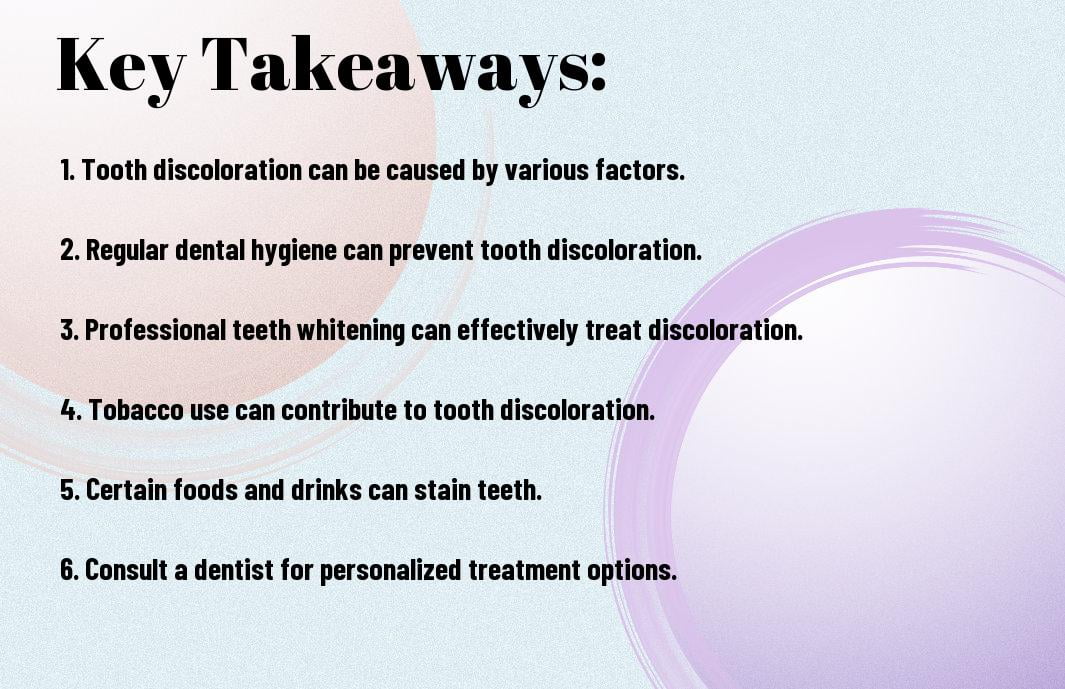You may have noticed discoloration on your teeth, impacting your smile and confidence. In this post, we will research into the causes of tooth discoloration and explore solutions to regain a bright, healthy smile. From everyday habits to underlying health issues, discovering the root of your tooth discoloration is the first step towards finding effective treatments. Let’s uncover the dangerous factors that contribute to staining and the positive steps you can take to restore your pearly whites.
Key Takeaways:
- Causes of Tooth Discoloration: Various factors can contribute to tooth discoloration, including consuming staining beverages like coffee or tea, smoking, poor oral hygiene, and certain medications.
- Types of Tooth Discoloration: Tooth discoloration can be categorized as extrinsic, which affects the outer layer of the tooth, or intrinsic, which affects the inner structure of the tooth.
- Solutions for Tooth Discoloration: Treatment options for tooth discoloration include professional teeth whitening, dental bonding, veneers, and improving oral hygiene habits to prevent further discoloration.
Understanding Tooth Discoloration
The Anatomy of a Tooth
The enamel, the outer layer of the tooth, is semi-translucent and can be easily stained by dark-colored liquids such as coffee or wine. The dentin, beneath the enamel, can also contribute to tooth discoloration if it becomes more exposed due to wear and tear.
Types of Tooth Discoloration
Tooth discoloration can be classified into two main types: intrinsic and extrinsic. Intrinsic discoloration occurs within the tooth and is usually caused by factors like trauma or medication. Extrinsic discoloration, on the other hand, affects the outer layer of the tooth and is typically caused by consuming dark-colored foods or poor oral hygiene.
| Type | Cause |
| Intrinsic | Trauma or medication |
| Extrinsic | Dark-colored foods or poor oral hygiene |
For instance, intrinsic discoloration may be difficult to treat with regular whitening methods as the stains are within the tooth structure. In contrast, extrinsic discoloration can often be improved through professional dental cleanings and teeth whitening treatments.
- Important: Intrinsic discoloration may require more extensive dental procedures to address.
- Dangerous: Ignoring extrinsic discoloration can lead to more serious dental issues.
- Positive: Early treatment for both types of discoloration can result in a brighter, healthier smile.
| Type | Treatment |
| Intrinsic | May require more extensive dental procedures |
| Extrinsic | Professional dental cleanings and teeth whitening treatments |
Causes of Tooth Discoloration
Extrinsic Causes
Even with regular brushing and good oral hygiene, teeth can still become discolored due to extrinsic factors. Extrinsic causes of tooth discoloration include the consumption of pigmented foods and beverages, such as coffee, tea, red wine, and berries. Smoking is also a common culprit, as the tar and nicotine in cigarettes can stain teeth over time. Proper dental hygiene and routine cleanings can help prevent and address extrinsic discoloration.
Intrinsic Causes
An improper diet isn’t the only reason your teeth may lose their shine. Intrinsic causes of tooth discoloration go beyond the surface and can stem from factors such as trauma to the tooth, certain medications like tetracycline antibiotics, excessive fluoride during tooth development, or genetics. These causes affect the inner structure of the tooth, making it harder to treat with simple cleaning and whitening procedures.
Discoloration due to intrinsic factors may require more advanced treatments such as bonding, veneers, or crowns to restore the natural appearance of the tooth. Consulting with a dental professional is crucial to determine the underlying cause and appropriate solution for your specific case of tooth discoloration.
Preventative Measures
Dietary Choices
Now, let’s address the impact of dietary choices on tooth discoloration. To prevent stains from forming on your teeth, it is crucial to be mindful of what you consume. Foods and beverages such as coffee, tea, red wine, and dark sodas are notorious for staining teeth. Limiting the intake of these items can help maintain a bright smile.
Oral Hygiene Practices
Choices in oral hygiene practices play a significant role in preventing tooth discoloration. Regular brushing and flossing are necessary to remove plaque and prevent stains from settling on your teeth. Using a whitening toothpaste containing fluoride can also help in maintaining the natural color of your teeth.
Measures like scheduling regular dental cleanings can aid in the early detection of any discoloration and prevent it from worsening. Additionally, making informed choices about your oral health products, such as opting for non-abrasive toothpaste, can go a long way in preserving the whiteness of your teeth.
Treatment Options for Discolored Teeth
Over-the-Counter Remedies
Over-the-counter remedies can be a good starting point for addressing mild tooth discoloration. Whitening toothpaste, strips, and trays are widely available and can help to lighten surface stains. Keep in mind that these solutions may not provide drastic results for more severe discoloration, but they can be effective in maintaining a brighter smile after professional treatment.
Professional Dental Procedures
Professional dental procedures offer more advanced solutions for treating discolored teeth. Options such as in-office whitening treatments, veneers, and bonding can deliver more noticeable and lasting results. Your dentist can customize a treatment plan based on the severity and underlying cause of your tooth discoloration, ensuring a safe and effective procedure tailored to your specific needs.
When considering professional dental procedures for tooth discoloration, it’s necessary to consult with a qualified dentist to assess the best course of action for your individual case. Professional dental treatments are typically more potent and can yield faster, long-lasting results compared to over-the-counter options. By seeking guidance from a dental professional, you can achieve a brighter, whiter smile with confidence.
Conclusion
Ultimately, understanding the various causes of tooth discoloration is crucial in finding the right solutions to achieve a bright and healthy smile. By being aware of factors such as diet, lifestyle choices, and dental hygiene practices, individuals can make informed decisions to prevent and treat tooth discoloration. Consulting with a dentist for professional advice and treatments, such as teeth whitening or veneers, can also help restore the natural color of teeth and boost confidence. Do not forget, maintaining good oral hygiene and making healthy lifestyle choices are key in preserving the brightness and health of your smile.
FAQ
Q: What causes tooth discoloration?
A: Tooth discoloration can be caused by various factors such as poor oral hygiene, consumption of staining foods and beverages, smoking, aging, certain medications, and genetic factors.
Q: Can tooth discoloration be prevented?
A: Yes, tooth discoloration can be prevented by maintaining good oral hygiene practices, avoiding foods and drinks that stain teeth, quitting smoking, and visiting the dentist regularly for professional cleanings and check-ups.
Q: What are the solutions for tooth discoloration?
A: The solutions for tooth discoloration include professional teeth whitening treatments, dental veneers, bonding, and crowns. It is important to consult with a dentist to determine the most appropriate treatment based on the cause and severity of the discoloration.







